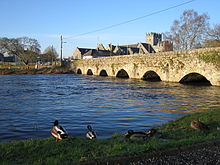River Suir: Difference between revisions
Created page with "thumb|right|220px|River Suir at [[Holycross, Tipperary]] The '''River Suir''' is a river in Ireland that flows into the Atlantic Ocean near ..." |
No edit summary |
||
| Line 10: | Line 10: | ||
[[File:Castles of Munster, Ardfinnan, Tipperary - geograph.org.uk - 1393364.jpg|220px|thumb|River Suir at [[Ardfinnan]] in Tipperary.]] | [[File:Castles of Munster, Ardfinnan, Tipperary - geograph.org.uk - 1393364.jpg|220px|thumb|River Suir at [[Ardfinnan]] in Tipperary.]] | ||
Together with the Nore and the Barrow, the river is one of the trio known as The Three Sisters. | Together with the Nore and the Barrow, the river is one of the trio known as [[The Three Sisters]]. | ||
The Suir is known in Irish as the ''Siúr'' and it is thought the present spelling in English with the u and i reversed is due to a mistake. Some people therefore feel that the spelling in English should be Siur and this spelling is occasionally seen. Edmund Spenser (1552–1599) author of the ''The Fairie Queene'', in his writings during the Elizabethan age while domiciled in [[County Cork]], referred to the 'gentle Shure', probable a most accurate spelling and the most phonetically correct of the period. | The Suir is known in Irish as the ''Siúr'' and it is thought the present spelling in English with the u and i reversed is due to a mistake. Some people therefore feel that the spelling in English should be Siur and this spelling is occasionally seen. Edmund Spenser (1552–1599) author of the ''The Fairie Queene'', in his writings during the Elizabethan age while domiciled in [[County Cork]], referred to the 'gentle Shure', probable a most accurate spelling and the most phonetically correct of the period. | ||
Revision as of 11:04, 17 March 2016

The River Suir is a river in Ireland that flows into the Atlantic Ocean near Waterford after a distance of 115 miles.[1] The catchment area of the River Suir is 1,400 square miles.[2] The long term average flow rate of the River Suir is 17,000 gallons per second[3] - This is more than twice the flow of the River Barrow.
Popular with anglers, it holds plentiful reserves of brown trout. While the Suir holds the record for a salmon taken from an Irish river (weighing 57lb, taken on a fly in 1874), as is the case in many other Atlantic rivers, salmon stocks have been in decline in recent years.[4]
Rising on the slopes of Devil's Bit Mountain, just north of Templemore in County Tipperary, the Suir flows south through Loughmore, Thurles, Holycross, Golden and Knockgraffon. Merging with the River Aherlow at Kilmoyler and further on with the Tar, it turns east at the Comeragh Mountains, forming the border between County Waterford and County Tipperary. It then passes through Cahir, Clonmel and Carrick-on-Suir before reaching Waterford. Near the Port of Waterford it meets the River Barrow at Cheekpoint to form a wide navigable estuary, capable of accommodating seagoing vessels up to 32,000 tons dwt. It exits to the sea between Dunmore East and Hook Head.

Together with the Nore and the Barrow, the river is one of the trio known as The Three Sisters.
The Suir is known in Irish as the Siúr and it is thought the present spelling in English with the u and i reversed is due to a mistake. Some people therefore feel that the spelling in English should be Siur and this spelling is occasionally seen. Edmund Spenser (1552–1599) author of the The Fairie Queene, in his writings during the Elizabethan age while domiciled in County Cork, referred to the 'gentle Shure', probable a most accurate spelling and the most phonetically correct of the period.
In the early years of the 21st century, the remains of a very large Viking settlement were found at a bend in the river at Woodstown just upstream from Waterford.
In Clonmel, the Suir floods the local area after very heavy rainfalls falling in the up river catchment of 840 square miles. The Office of Public Works (OPW) completed and installed a Flood Forecasting System which was used to forecast flooding in January 2008 and January 2009, the flooding of January 2009 being a 1 in 5-year event. Phase 1 of the Clonmel Flood defence (1–100-year) which stated in 2007 is scheduled for completion in late 2009 and phase two and three as one contract by 2011/2012. The flood defence consists of demountable barriers, walls and earth banks. The Gashouse Bridge, Coleville Road, Davis Road, the quays and the Old Bridge are generally the worst affected areas. Clonmel is not tidal. The tide turns above the Miloko chocolate crumb factory in Carrick-on-Suir. The flood waters spill onto the land above Miloko on the County Waterford side of the river.
Carrick-on-Suir is tidal and has a 1–50-year flood defence. The Office of Public Works (OPW) now plan to install a 1–200-year flood defence where the river Suir flows through Waterford city.
Where the river flows through south County Kilkenny, near the town of Mooncoin, was written one of the most famous Irish ballads, called The Rose of Mooncoin, which includes the lines "On the banks of the Suir, that flows down by Mooncoin".
References
- ↑ [1] River Suir, Ireland's Fisheries
- ↑ South Eastern River Basin District Management System. Page 38 [2]
- ↑ South Eastern River Basin District Management System. Page 38 [3]
- ↑ Taverner,, Eric; John Moore (2006). The Angler's Weekend Book. READ BOOKS,. pp. 495. ISBN 978-1-4067-9791-6. http://books.google.ie/books?id=tGLnwX93_eQC&pg=PA495&dq=salmon+57+record++maher+suir#v=onepage&q=salmon%2057%20record%20%20maher%20suir&f=false.